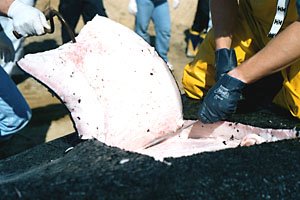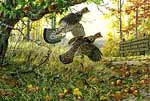(This post first appeared on February 12, 2009. Updates including today's appear below in chronological order.)
Santa brought me The Omnivore's Dilemma by Michael Pollan. Written in 2006, it's a thought provoking book about where our food comes from. No sooner had I finished it than the February, 2009 issue of Best Life arrived. Its “The One That Got Away” focuses on omega-3 fatty acids, high on the list of Good Stuff championed in Dilemma.Not wanting to be left off the omega-3 bandwagon, I went rummaging around my hard drive for a draft I started in 2006. Here's what it looked like:
 I remember my Dad saying "fish is brain food" every time we had seafood when I was a kid. He enjoyed telling me about his barefoot 13 mile treks to school through winter's snow and summer's heat even more. If I recall correctly, it was uphill each way, too. Over the years, those little fish-as-brain-food nuggets migrated to my memory's back burner along with Dad's marathon walks.
I remember my Dad saying "fish is brain food" every time we had seafood when I was a kid. He enjoyed telling me about his barefoot 13 mile treks to school through winter's snow and summer's heat even more. If I recall correctly, it was uphill each way, too. Over the years, those little fish-as-brain-food nuggets migrated to my memory's back burner along with Dad's marathon walks.At the barber shop recently for my annual hair cut, I absently grabbed a magazine on my way to the chair. Before I could swap The Economist for something more user friendly, I was already swaddled in that bed sheet thingie, so I settled in and soldiered on. While browsing for a really short article not written in Greek, I found this:
"The latest piece of research is into omega-3 fatty acids. Their effects on adults are well established (they can, for example, reduce the feeling of anger in some people who cannot control their tempers). But it now seems that an inadequate intake of them by a pregnant woman puts her child at greater risk of being stupid, clumsy and friendless.... The researchers showed that the children of mothers who ate food with little omega-3 content had a lower IQ than their peers, found normal social relations harder to deal with, and lacked fine-tuned physical co-ordination."Fried chicken trumped poached salmon on Mom's dinner table every time. No wonder 8th grade was so tough on my first time around.
 In 1970, Danish researchers discovered that the Eskimos have a great coronary health record. The scientists wondered how this could be, since the weather way up North isn't suited to growing all those fruits and vegetables we know we're supposed to eat but hate anyway. "Vegetables are what real food eats," the bumper sticker snickers. I gather the scientists were startled as snared stoats when they put two and two together and concluded that all the whale, seal and salmon the Eskimos eat is precisely what keeps their tickers healthy. Cold-water seafood of all stripes is a great source of essential omega-3 fatty acids.
In 1970, Danish researchers discovered that the Eskimos have a great coronary health record. The scientists wondered how this could be, since the weather way up North isn't suited to growing all those fruits and vegetables we know we're supposed to eat but hate anyway. "Vegetables are what real food eats," the bumper sticker snickers. I gather the scientists were startled as snared stoats when they put two and two together and concluded that all the whale, seal and salmon the Eskimos eat is precisely what keeps their tickers healthy. Cold-water seafood of all stripes is a great source of essential omega-3 fatty acids.Duplicating that diet could be a problem for some of us. Just the other day, my wife went looking for some fresh blubber at the local supermarket. For some reason, they thought she was joking. Naturally she then asked for salmon sperm sacs. These are real winners, omega-3 wise, and have long been considered a delicacy by native peoples. She was told quite frostily that, since sperm sacs aren't yet "an acquired taste" here in NY, the supermarket didn't stock them, either.
Even if some food retailers might be reluctant to carry these flavorful treats, there's plenty of great substitutes for them. Salmon, halibut, tuna and mackerel are almost as good as blubber or sperm sacs for supplying heart-healthy omega-3s. Eat 'em twice a week and help the old ticker.

Issues surrounding food, nutrition, and health are increasingly prominent in today's news. Writers like Michael Pollan have certainly popularized the "question of what we should have for dinner." In Dilemma, he lists four major sources of Americans’ food, from “industrial agriculture” and its CAFOs at one end to hunting and foraging at the other. Mr. Pollan puts “industrial organic” and local self sufficient farms somewhere in between. Readers who have shown the energy to find Cold Duck will certainly have the wit to form their own impressions of Dilemma, so the book review ends right here.
I’m more interested that The Economist's position on omega-3s is widely expanded in Dilemma and the Best Life article. The benefits claimed for a healthy dose of these fatty acids in the diet jump from producing smarter kids and less angry adults to the diminution of “so-called diseases of civilization: asthma and arthritis, depression and Alzheimer’s, heart disease and cancer, as well as… diabetes and obesity.” And Best Life is not shy about its claims, either, telling us to “Lose the skepticism. This isn’t the next oat bran.”
Omega-3s are produced in plants’ leaves while related acids, omega-6s, are produced in their seeds. Humans' joints and organs don't know a seed from a leaf, of course. But they understand that omega-3s are anti-inflammatories while omega-6s are just the opposite. And apparently our 21st century bodies are plenty inflamed. The ratio of omega-6: omega-3 in ancient hunter-gathers’ diets approximated 1:1. Western man, it is claimed, highly overweights omega-6s in his diet, sometimes by as much as 20:1. To lower this ratio back toward 1:1, either omega-6 consumption must be reduced, or omega-3 consumption increased.
That’s why those Danish scientists’ findings are so important. Cold-water fish contain higher levels of omega-3s than land animals. Eating such fish is part of the answer. But meat, eggs and milk from pastured animals (grass eaters) contains higher levels of omega-3s than the same products taken from animals that are fed grain (seed eaters). Although it's contrary to contemporary “common knowledge,” grass-fed beef may be better for humans than grain-fed farmed salmon. It’s not so much what you eat, then, but what you eat eats. That bumper sticker actually has it partially right.
The “what you eat eats” part is slick and catchy. I like it. But, among the several questions I’d like to ask Pollan and the others over a few beers, here’s a starter. If acid rain is drenching our grasses here in upstate NY, and “you are what you eat eats,” then what am I to think of eating local grass-fed beef? I hope there’s no problem at all, but I lack the scientific background to reach an intelligent conclusion myself. I’ll have to keep my eyes open.
In the end, Dilemma and Best Life offer essentially the same conclusion as The Economist. Eat more seafood, especially shellfish and smaller fatty fish such as herring, mackerel, anchovies, and sardines. God bless my Dad: he was right all along.
For fans of hunting-gathering good food from wild places close to home, Cold Duck recommends The Wild Harvest Table. It’s written by some cagey friends in central NY who can talk the talk because they walk the walk. I'm pleased to include Table as a permanent resident in our links.
April 25, 2009
Articles that catch my eye seem to sneak in "Michael Pollan" or "high-fructose corn syrup" or "locavore" a lot these days. What's up with that?
This piece in the April/ May "Garden & Gun" addresses the lure of Coca Cola sweetened the old fashioned way with cane sugar.
Since my subscription kicked in last year, I find myself checking the mailbox about two weeks early for "Garden & Gun." I'm going to pop it into our permanent links section.
August 2, 2009
This dairy farm can supply much of Chicago's demand for fresh milk. I wonder whether Pollan would consider the farm Heaven or Hell. Watch and form your own opinion.





1 comment:
Great post, Michael!
I knew my dear Mom should have been imbibing some of that Cod Liver Oil that she relished spooning into my mouth every morning, right along with me.
Post a Comment